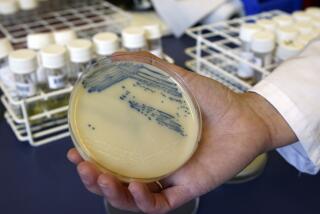Staph cases ‘steadily growing’
- Share via
Hospitalizations associated with a drug-resistant form of a Staphylococcus bacterium doubled over six years in the United States to nearly 280,000 cases in 2005, according to a new study published Thursday that provides a wider picture of the bug’s impact.
The rise in illnesses from methicillin-resistant Staphylococcus aureus, also known as MRSA, stemmed mostly from an explosion in the number of skin and soft-tissue infections, which are typically associated with strains acquired outside of hospitals, the study found.
The figures provided the first good look at national trends over time, said Dr. Elizabeth Bancroft, a medical epidemiologist at the Los Angeles County Department of Public Health who was not involved in the study. “It gives us more evidence that this bug has been here for a while and has been steadily growing,” she said.
The study analyzed data from the National Hospital Discharge Survey, a federal database of discharge records from about 500 hospitals, and the Surveillance Network Database-USA, a database of drug-resistance tests compiled by Focus Diagnostics Inc., said senior author Ramanan Laxminarayan, an epidemiologist with the nonprofit research group Resources for the Future.
Extrapolating from these sources led his team to estimate about 127,000 hospitalizations associated with MRSA in 1999 and about 278,000 in 2005.
Researchers found that the number of blood poisoning and pneumonia cases associated with MRSA increased modestly during that time, while the number of infections in other forms -- such as skin infections -- nearly tripled. The death toll rose from 4,700 in 1999 to about 6,600 in 2005, according to the study.
The report, published in the journal Emerging Infectious Diseases, was somewhat at odds with a widely publicized study in October of MRSA rates in the United States.
That study focused on only the most serious kinds of MRSA infections, such as blood and lung fluid infections, using data from nine metropolitan areas across the country. It estimated that 94,000 Americans suffered invasive MRSA infections in 2005 and that about 19,000 of them died.
Laxminarayan put the disparities down to a difference in methodology and interest in answering a different question: “I would trust the CDC study better for levels. I would trust our study better for trends.”
The dominance of skin infections in the new analysis provides a nugget of good news, said Dr. Scott Fridkin, a researcher at the U.S. Centers for Disease Control and Prevention who worked on last month’s study.
“Skin infections don’t tend to be life-threatening,” he said.
--






